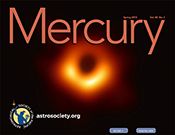Spring 2019 - Volume 48, Number 2

Table of Contents
[6] Space News
A rundown of some of the most exciting developments in space and time.
[26] Cosmic Views, Jason Major
NASA’s Juno mission gets a stormy view and what were those lights in Arctic skies?
[28] Lifting the Curtain, Steve Murray
After decades of wondering, the Event Horizon Telescope reveals what a black hole really looks like.
[35] The Little Spacecraft That Almost Did, Tracy Staedter
On April 11, Israel’s dreams of landing its first spacecraft on the Moon ended after Beresheet crashed into the lunar surface.
[39] Apollo’s Biomedical Lessons, David Warmflash, MD
Future lunar explorers will thank the medical research and physiological observations of the NASA astronauts who first set foot on the Moon’s surface nearly 50 years ago.
Departments
[3] Perspectives, Ian O’Neill
Einstein Was Wrong
[4] First Word, Linda Shore
The New Face of Mercury
[5] Mercury News
Coming Soon! Mercury Online
[12] Annals of Astronomy, Clifford J. Cunningham
The Occultations of Regulus and Aldebaran in 1347
[14] Astronomer’s Notebook, Jennifer Birriel
When Darkness Swallows the Moon
[16] Armchair Astrophysics, Christopher Wanjek
As the Saying Goes, You Ain’t Seen Nothing Yet
[18] Research Focus, M. Katy Rodriguez Wimberly
Are Globular Clusters and UFDs Celestial Siblings?
[20] Education Matters, Brian Kruse
The First Black Hole Image: A Teachable Moment?
[22] A Little Learning, C. Renee James
Left to Their Own Devices
[26] Guest Observer, William Romanishin
The Dangers of Collaborative Learning
Lifting the Curtain (Feature)
By Steve Murray
Well, the wait is over. On April 10, a series of international press conferences gave audiences their first-ever view of a black hole: an image of a fuzzy black circle surrounded by a blotchy smear of yellow and red that may transform astrophysics. But the road to this historic achievement was long and arduous.
The Little Spacecraft That Almost Did (Feature)
By Tracy Staedter
From a mission control room near Tel Aviv, Israel, dozens of people waited as the spacecraft Beresheet came out of its orbit around the Moon to attempt a lunar landing. Only three other countries in the world have touched down there safely: Russia, China and the United States. Israel was trying to be the fourth. Engineers and space scientists from SpaceIL and Israel Aerospace Industries (IAI) had already worked together to overcome so many hurdles, financial and technical, since Beresheet’s conception in 2011 that it seemed they couldn’t fail. Their quiet anticipation filled the silent gaps between mission control status updates of the craft’s descent. And then came the devastating words: “We seem to have a problem with our main engine.”
Apollo’s Biomedical Lessons (Feature)
By David Warmflash, MD
In 1939, visionaries of the British Interplanetary Society (BIS) conceived of a mission that would take three people to the surface of the Moon for 14 days. Unexpectedly, humans did start traveling to the Moon only three decades later, though for stays ranging from just under one day to just over three. Today, nearly fifty years have passed since Neil Armstrong and Buzz Aldrin became the first moonwalkers on July 20, 1969. Plans now beckon for new-piloted lunar missions, this time with stays on the lunar surface at least as long as the BIS two-week vision. Are we actually ready for it?
NASA Uses Color to Catch the Solar Wind (Cosmic Views)
By Jason Major
These aren’t giant alien jellyfish coming to take over the Earth (although I, for one, welcome our new cnidarian overlords); they’re clouds of glowing gas released high over the Norwegian Sea by NASA rockets in order to track winds in the upper atmosphere.
